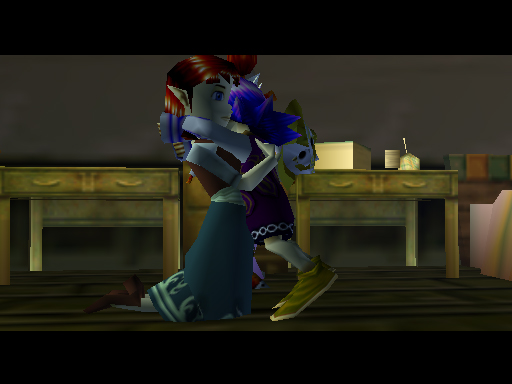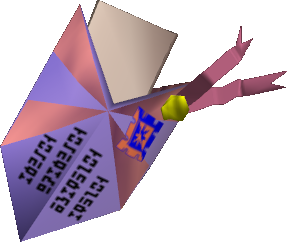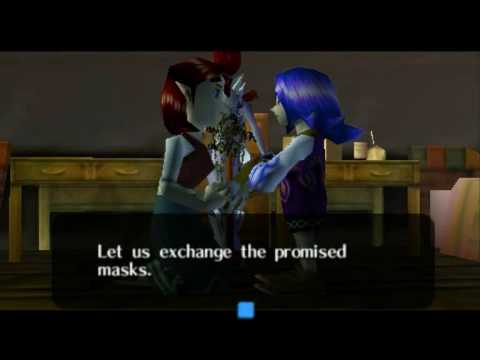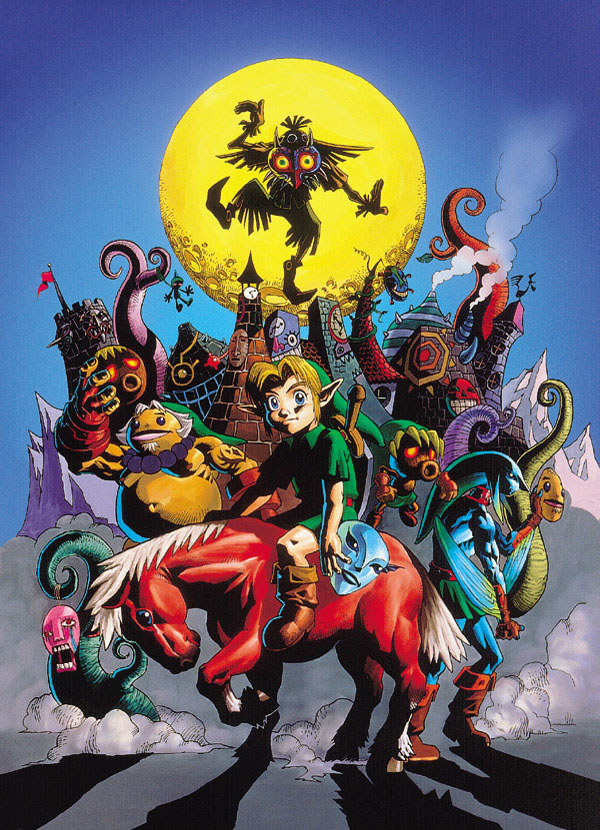A Study in Storytelling: the Role of Anju and Kafei in Termina.
Posted on April 02 2015 by Aaron Suduiko

When I first began the enterprise of analyzing the entirety of “Majora’s Mask,” I had no idea how I could best bring that analysis to a close. But a while ago, I found a point where it seems obvious to conclude: Anju and Kafei. In this final installment of With a Terrible Fate’s analysis of the original “Majora’s Mask,” I will try to convince you that the quest to reunite Anju and Kafei is as narratologically significant as the game’s main quest, and that it leaves us with unique insights about Termina and the world beyond.
When most people think of Anju and Kafei, they consider them in one of two lights: either they see them as the star-crossed lovers with one of the most well-articulated romances in the “Zelda” series, or, they see them as the longest, most frustrating side quest in “Majora’s Mask” — a quest in which it is easy to misstep, at which point one has to start from its beginning in a new three-day cycle. In this article, I’m going to try to unite these two perspectives to attack the ontology of Termina from the perspective of love.

It will be worthwhile to sketch the general arc of the quest before we continue — feel free to skip to the next paragraph if you are already well acquainted with it. Anju is a young woman who runs Clock Town’s inn; Kafei is the mayor’s son. They are engaged to be married, but Kafei has gone missing at the time that Link enters Termina. It turns out that Skull Kid has cursed Kafei, and Kafei’s body has turned into that of a child; but this is not reason why he has gone into hiding. Rather, the reason is because a thief, Sakon, stole his ceremonial wedding mask, and he feels he must retrieve it before meeting with Anju to be married. The quest demands much of Link if Anju and Kafei are to be reunited: he must meet with Anju, locate Kafei, locate Sakon, send letters back and forth between Anju and Kafei, infiltrate Sakon’s hideout with Kafei, bear witness to the wedding — and this isn’t even an exhaustive list of Link’s tasks.
The quest to reunite Anju and Kafei exemplifies what I have previously said about sidequests in “Majora’s Mask.” Completing the quest requires that Link fails to save someone: he must not intervene when Sakon robs the owner of Clock Town’s bomb shop, because Kafei only discovers where Sakon’s hideout is by eavesdropping when Sakon pawns the stolen goods. Not only does the quest take an entire three-day cycle to complete, with Anju and Kafei marrying just moments before the moon is set to fall, but it’s also implied by the structure of the game that the player is meant to go through the quest more than once — and it is here that I want to dig into analysis.

If the player wants to explore the entirety of Termina, insofar as acquiring every item in the game is concerned, then she must complete the Anju and Kafei sidequest at least twice. The reason why is this: when Kafei leaves to raid Sakon’s hideout and retrieve his mask, he leaves a special letter to his mother (pictured above), the Postmistress, explaining why he had gone into hiding. Link can deliver this to the Postmistress himself, in which case she thanks him by giving him a bottle filled the Chateau Romani, the most potent potion in the game.
But Link can also give the letter to the Postman; even though it is the middle of the night, he will promptly deliver it because it is Priority Mail. This leads to the sequence of events I described in my analysis of the Postman, which end in the Postman being liberated and giving Link the Postman’s Hat. This event is mutually exclusive, within a single timeline, from Link receiving the bottle of Chateau Romani. It is in this way that decision points inhere to the structure of the quest.
Link has to make more choices, though, if he’s to make it through this quest. As I have said, the ceremony in which Anju and Kafei marry, from which Link obtains the Couple’s Mask (proof of their union), occurs mere minutes before Moonfall. There are two important points to be made here: firstly, as I have said before, Link has just enough time after the ceremony, if he hurries and has already freed the four giants of Termina, to reach the Clock Tower, stop Skull Kid and defeat Majora. If he does so, then a proper wedding ceremony of Anju and Kafei actually takes place during the credits — pretty much the only agency the player is capable of expressing over the credits.
Secondly, when Anju and Kafei do reunite, they are resolved to stay in Clock Town, not fleeing the moon with everyone else. To quote them, they plan to “greet the morning… together.” This complicates things, because if Link does save them, there is an uncomfortable sense that he has gone against their wishes: they hold another ceremony in the credits, even though they already performed the act of marriage and celebration of their love in private. They must face their families, which we know is not an entirely comfortable situation — at one point during the three-day cycle, Link can overhear Anju arguing with her mother, because her mother believes Kafei ran off with Cremia, the milk maid. It’s vaguely reminiscent of what the lives of Romeo and Juliet might have been like if they hadn’t died at the end of the eponymous play.

What I’m driving at here is that the story of Anju and Kafei is deeply embedded within the narrative of “Majora’s Mask,” even though it advances the main plot of the story in no way whatsoever. To complete just about any optional aspect of the game — Pieces of Heart, Bottles, Masks — you must take a path that eventually leads to this quest. In light of this, I wish to close my analysis of “Majora’s Mask” by attempting to answer one question: are Anju and Kafei “meant to be”?
Clichéd though its formulation may be, neither the question nor its answer is trivial. We have seen how complicated Termina’s metaphysics of free will /determinism is; take this in combination with the ambivalence about saving Anju and Kafei, along with the fact that the quest to reunite them is optional, and it becomes very difficult to parse what the phrase ‘meant to be’ means. Nevertheless, I claim that the phrase is meaningful, and that understanding the question’s answer will tie together our understanding of “Majora’s Mask” as a work of art. Let me show you why this is the case.
Anju and Kafei are the very definition of star-crossed lovers: despite their love for one another, they will always be kept apart in the unfolding events of Termina’s final days, unless Link chooses to intervene. Even if Link does intervene, it is the longest and most trying sidequest in the game, making it a significant struggle to actually bring them together in the end. If they are united, it seems as though their desire is to die together, rather than to seek any possible avenue of survival — so much so that saving the world after saving them seems to act against their wishes, an idea which is reinforced by the completion of the game requiring you go through their quest multiple times, thereby dooming them at least once by playing the Song of Time and abandoning that timeline.
Take all of these observations together, and it seems as though the reuniting of Anju and Kafei actually countervails the main plot. You must take significant time away from the completion of the main plot to complete the quest even once, and the quest seems to suggest that the desired outcome is the player playing the Song of Time and leaving the lovers to perish together, reunited. Given the breadth of the quest, as well as its centrality to so many domains of the game outside of the main plot, I would venture to say that the quest to reunite Anju and Kafei actually constitutes a secondary plot within the conceit of the game.
It’s crucial to properly parse what I mean by ‘secondary plot’, because the claim I am making is that the sidequest is of a higher status than other sidequests in the game. This is a storyline that fills the entire three-day stretch that constitutes a timeline in Termina, and that has an ending which seems to be in opposition to the resolution of the main plot. What we have in the instance of Anju and Kafei, therefore, is an instance of not just an optional collection quest or event, but an entire optional storyline which exists adjacent to the explicit story arc of Link vs. Skull Kid. This plot line goes so far as to actually allows the player to play as Kafei when he and Link storm Sakon’s hideout — this is the only moment in the game when the player can control someone other than Link. It is evident, I think, that something more than a mere sidequest is at play here.
Are Anju and Kafei meant to be? It is up to you. What this secondary plot reflects at its core is the capacity for video games to impose narrative structures and choices that are completely alien to other media. It is as if, hidden in the scenes of “Julius Caesar,” Romeo and Juliet were striving to find a way to be together; and, at your discretion while watching the play, you could push Caesar to the sidelines and watch “Romeo and Juliet” instead. Then, watching “Romeo and Juliet,” you could also decide the fate of the star-crossed lovers, somehow all within the context of “Julius Caesar.” We can’t well imagine how this would work in other media because it cannot work in other media; but in the case of video games, instances like Anju and Kafei allow the player to question and respond to the privilege that the main plot of a story is given.

If you would rather make “Majora’s Mask” a love story than tell the tale of Link facing Skull Kid and coming to terms with the nature of Majora and the universe, then you can. If you want to unify the storyline of reuniting the lovers and saving the world, the very mechanics of the credits support your ability to do so. If you want to completely ignore the plight of Anju and Kafei, then you can complete the main plot without ever even learning their names. What Anju and Kafei are ‘meant to be’ is a story: their fates over the course of Termina’s three days are irrevocably intertwined, and in this way, like the moon and Termina, like the main plot and secondary plot, they will always be related to each other in a way that demands explanation. But the explanation that the world of the game gives that relationship depends upon the player’s choice of how to interact with the world. This is why I have chosen to conclude the analysis of “Majora’s Mask” with an examination of Anju and Kafei: the status of their story shows that the apocalyptic nature of Termina is deceptive. Just behind the impending doom is a world teeming with stories, and on countless levels, you are the one who decides which story to tell.
All you have to do is meet with a terrible fate.
And with that, friends, I conclude my analysis of “Majora’s Mask,” and probably won’t return for it for some time, except in order to analyze how “Majora’s Mask 3D” functions in relation to the original piece of art. Thank you dearly for taking the time to read and follow my work. If you’d like to catch up on earlier articles in the series, then head on over to With a Terrible Fate’s hub page. And of course, this is not the end of my analytic work altogether! If you have any suggestions as to what game you’d like to see my analyze next, feel free to say something in the comments or drop me a line at withaterriblefate@gmail.com. Take care, and I’ll see you next time.
Aaron Suduiko, Phillips Exeter Academy ’13, Harvard University ’17. Studies philosophy with a focus on developing new aesthetic theory with a grounding in the medium of video games. In 2013, he conducted a comparative analysis of role playing paradigms in video games (“Legend of Zelda: Majora’s Mask,” “Nier,” “Dishonored,” and “Deus Ex: Human Revolution”) and plays (“Six Characters in Search of an Author,” “The Man in the Iron Mask,” “Macbeth,” and “Flowers for Algernon.” He is the author of “With a Terrible Fate,”a twice-weekly analysis of “Majora’s Mask” that is published by Zelda Dungeon and is set to continue through the release of the 3D remake this coming spring. Suduiko is reachable at withaterriblefate@gmail.com.



